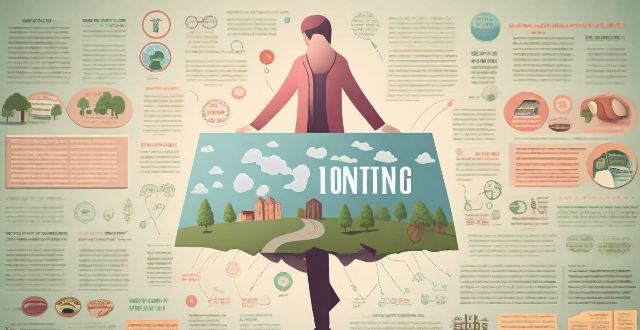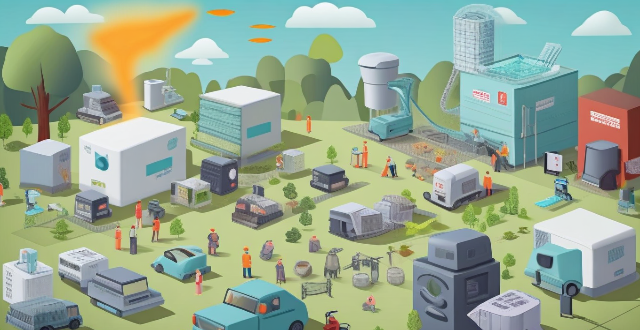Term Pollution

What are the long-term effects of air pollution on our health ?
The long-term effects of air pollution on health are wide-ranging and severe, affecting individuals and entire communities. Respiratory diseases, cardiovascular diseases, neurological disorders, reproductive health problems, and other health issues have all been linked to exposure to polluted air. It is essential to address air pollution as a public health issue to protect the health and well-being of people worldwide.

What are some innovative solutions for controlling plastic pollution in developing countries ?
The text discusses innovative solutions for controlling plastic pollution in developing countries, including promoting recycling and waste management, encouraging alternative packaging materials, educating the public on plastic pollution, implementing bans on single-use plastics, and investing in research and development.

How does air pollution caused by climate change affect children ?
The provided text discusses the impact of air pollution, exacerbated by climate change, on children's health. It outlines both immediate and long-term health effects, including respiratory issues, developmental concerns, chronic conditions, and potential for other health problems. The text also highlights the socio-economic impact of these health issues, such as school performance and healthcare costs. Prevention and mitigation strategies are suggested, including reducing pollution sources, promoting clean energy, awareness and education, and urban planning. The conclusion emphasizes the need for collective action to protect children's health and future.

How often should air quality monitoring be conducted ?
Air quality monitoring is crucial for ensuring safe and healthy air, with the frequency of such monitoring influenced by various factors. Urban areas typically require daily monitoring due to high pollution levels, while rural areas may only need weekly or monthly checks. Special situations, like emergencies or natural disasters, might necessitate continuous monitoring. The goal is to balance between tracking long-term trends and identifying short-term spikes in pollution, all while considering available resources.

What are the long-term effects of plastic pollution on the environment ?
The article discusses the long-term effects of plastic pollution on the environment, including soil degradation, impact on aquatic ecosystems, harm to wildlife, human health risks, and economic impact. It emphasizes the need for collective efforts to reduce plastic consumption and properly dispose of waste to protect the planet.

What is the role of businesses in controlling plastic pollution ?
Businesses have a crucial role in controlling plastic pollution. They can reduce plastic production by switching to biodegradable materials and improving recycling efficiency. Promoting sustainable practices, such as encouraging consumer responsibility and partnering with environmental organizations, is also essential. Investing in research and development for alternative products and improved recycling technologies further helps control plastic pollution. Businesses that prioritize sustainability will likely see long-term benefits in profitability and reputation.

How do clean production technologies help reduce waste and pollution ?
Clean production technologies are vital in reducing waste and pollution. They achieve this through energy efficiency, resource efficiency, improved waste management, pollution control, and a holistic approach to sustainability via life cycle assessment. By implementing these technologies, industries can operate in a more sustainable manner, minimizing their environmental impact.

How can governments implement policies to reduce plastic waste and pollution ?
Governments can implement policies to reduce plastic waste and pollution by banning single-use plastics, promoting recycling and composting programs, encouraging sustainable packaging practices, educating the public about plastic pollution, and collaborating with other countries and international organizations.

What impact does air pollution have on indoor sports facilities and athletes' health ?
Impact of Air Pollution on Indoor Sports Facilities and Athletes' Health: - **On Indoor Sports Facilities**: - Reduced visibility, unpleasant odors and tastes, equipment damage, and increased energy consumption due to air pollutants. - **On Athletes' Health**: - Respiratory problems, cardiovascular disease, asthma attacks, skin irritation, fatigue and lethargy, cognitive impairment, and immune system suppression due to exposure to air pollutants.

How does plastic pollution impact marine life and ecosystems ?
The text discusses the impact of plastic pollution on marine life and ecosystems, including entanglement and ingestion by animals, chemical pollution from toxic additives, habitat destruction, food chain disruption, economic impacts on tourism and fishing industries, aesthetic and cultural impacts on coastlines and ocean environments, and solutions and mitigation efforts such as reducing plastic use, improving waste management, cleanup campaigns, education and awareness, policy changes, and research and innovation.

Do hybrid cars produce less pollution than traditional gasoline cars ?
Hybrid cars generally produce less pollution than traditional gasoline cars, but the comparison is not straightforward and various factors must be taken into account.

What are the most effective ways to control plastic pollution ?
The text discusses the issue of plastic pollution and its harmful effects on the environment and human health. It provides various methods to control this problem, including reducing plastic use, recycling properly, supporting eco-friendly brands, implementing government policies such as banning single-use plastics, promoting recycling infrastructure, and investing in research and development for sustainable alternatives to plastic. The text emphasizes that controlling plastic pollution requires collective efforts from individuals, businesses, and governments to achieve a cleaner and healthier environment for all living beings on Earth.

What are the challenges faced by recycling facilities in controlling plastic pollution ?
Recycling facilities face numerous challenges in controlling plastic pollution, including logistical issues in collection and sorting, technological and economic constraints in processing, environmental concerns, and the need for public education. Addressing these challenges requires collaborative efforts from governments, industries, and individuals committed to reducing plastic pollution through effective recycling strategies.

How does proper waste management aid in saving energy and reducing pollution ?
Proper waste management is crucial for conserving energy and reducing pollution. It involves strategies like composting organic waste to reduce methane emissions, enhancing recycling to save energy in manufacturing new products, preventing environmental pollution through proper disposal, promoting sustainable practices like reduce, reuse, and recycle, and supporting the circular economy model. By adopting these measures, we can move towards a more sustainable future that conserves resources and protects our planet.

How can individuals contribute to reducing plastic pollution in their daily lives ?
Reducing plastic pollution requires individual effort and collective action. Here are key steps to minimize your plastic footprint: 1. **Bring Your Own Reusable Bags**: Avoid single-use plastic bags by carrying reusable shopping bags made from durable materials. 2. **Use Refillable Water Bottles**: Invest in a high-quality, BPA-free refillable water bottle to avoid buying bottled water. 3. **Say No to Single-Use Plastic Utensils**: Carry reusable utensils made from eco-friendly materials like bamboo or stainless steel. 4. **Opt for Bulk Foods**: Choose loose fruits and vegetables over pre-packaged ones and use reusable containers for bulk items. 5. **Choose Products with Less Packaging**: Opt for products with minimal or recyclable packaging and support eco-friendly brands. 6. **Recycle Properly**: Familiarize yourself with local recycling guidelines and ensure items are clean and sorted properly. 7. **Participate in Cleanup Events**: Join community efforts to remove plastic waste from the environment and raise awareness. 8. **Educate Others**: Share knowledge about plastic pollution and encourage others to adopt habits that reduce plastic use. 9. **Support Legislation and Policies**: Advocate for policies that reduce single-use plastics and promote recycling initiatives. By making these changes, individuals can contribute significantly to reducing plastic pollution and protecting the environment.

What is the significance of setting short-term versus long-term climate targets ?
The article emphasizes the importance of setting both short-term and long-term climate targets to effectively address climate change. Short-term targets focus on immediate actions, creating urgency, measurable progress, immediate benefits, and building momentum for more ambitious goals. Long-term targets ensure sustainability, deep decarbonization, adaptation, and global cooperation. Achieving these goals is crucial for mitigating the worst effects of climate change and creating a more resilient future.

Is there a difference between short-term and long-term memory in scientific terms ?
Short-term memory and long-term memory are two different types of memory with distinct characteristics. Short-term memory has a limited capacity, typically able to hold around seven items for a brief period, while long-term memory has a large capacity, virtually unlimited, and can store vast amounts of information for an extended period. Short-term memory lasts only for a few seconds unless it is repeatedly rehearsed or transferred to long-term memory, while long-term memory can last for minutes, hours, days, years, or even a lifetime. Short-term memory acts as a temporary holding place for new information, processing it before transferring it to long-term memory, while long-term memory stores information for future use, including facts, experiences, skills, and knowledge. Short-term memory has a faster retrieval speed since the information is readily available in the mind, while long-term memory has a slower retrieval speed as it requires more effort to recall the information from the vast storage. Short-term memory is more susceptible to interference and forgetting due to its transient nature, while long-term memory is more stable and less prone to interference, making it easier to retain information over time. Short-term memory requires rehearsal or encoding processes to transfer information to long-term memory, while long-term memory involves consolidation processes that strengthen neural connections and make the memory more durable.

What is the importance of long-term climate data analysis ?
Long-term climate data analysis is crucial for understanding the Earth's climate system and its changes over time. It provides valuable insights into past climate patterns and trends, which are critical for predicting future climate conditions and developing effective adaptation strategies. By continuing to collect and analyze long-term climate data, we can better prepare ourselves for the challenges posed by a changing climate and work towards a sustainable future.

What are some long-term saving strategies ?
Saving for the long term requires a disciplined approach and a solid plan. Here are some strategies to help you save effectively over the years: 1. Set clear financial goals: short-term, medium-term, and long-term. 2. Create a budget and stick to it by tracking expenses, cutting unnecessary costs, and automating savings. 3. Build an emergency fund that is easily accessible and covers at least 3-6 months' worth of living expenses. 4. Take advantage of employer matches and maximize contributions to retirement accounts like 401(k)s and IRAs. 5. Invest wisely with diversification, risk management, and a long-term perspective. 6. Manage debt by paying off high-interest debts first and considering refinancing options. 7. Regularly review and adjust your financial plan, adapting to life changes as needed. 8. Plan for taxes by choosing tax-efficient investments and being strategic about withdrawals and contributions. 9. Consider estate planning with wills, trusts, and life insurance to protect your family's financial wellbeing. 10. Continuously learn and seek advice from financial professionals when needed. By consistently implementing these strategies, you can build a strong financial foundation for your future.

How do I invest my money wisely for long-term growth ?
Investing wisely for long-term growth involves setting financial goals, creating a diversified portfolio, considering risk tolerance, investing for the long-term, and monitoring investments regularly.

How accurate are long-term climate predictions ?
Long-term climate predictions are essential for understanding potential future changes in the environment, but their accuracy is often questioned due to the complexity of the climate system. Factors that influence the accuracy of these predictions include uncertainty in emission scenarios, natural variability, and model limitations. However, advancements in climate modeling, such as higher-resolution models, ensemble modeling, and data assimilation techniques, have significantly improved our ability to make accurate predictions about future climate changes. By continuing to invest in research and development, we can further enhance the precision and reliability of long-term climate predictions, providing critical information for decision-makers and the public alike.

Can environmental legislation effectively reduce pollution ?
Environmental legislation has the potential to effectively reduce pollution, but its success depends on various factors such as enforcement and compliance, public awareness and participation, technological innovation, political will, international cooperation, and economic considerations. Strong regulatory bodies, education campaigns, investment in clean technology, government prioritization of environmental protection, global collaboration, and balancing environmental goals with economic development are all crucial for the effectiveness of environmental legislation. Achieving lasting improvements in environmental quality requires ongoing effort from all sectors of society.

What is the importance of long-term monitoring and evaluation in climate policy ?
The importance of long-term monitoring and evaluation in climate policy is discussed. Long-term monitoring and evaluation help ensure accountability for climate action, identify gaps and opportunities for improvement, inform future policies, build public trust, and promote sustainable development.